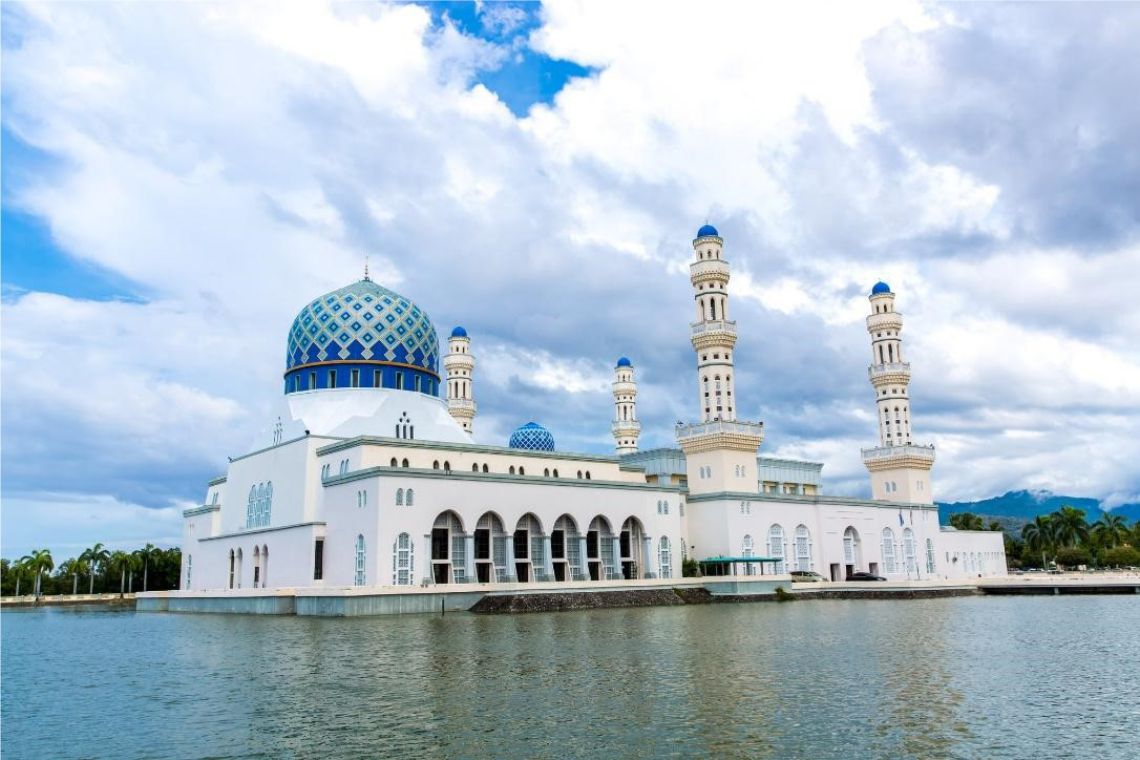The Kota Kinabalu City Mosque in Sabah’s state capital is a cultural landmark and a reflection of Islam’s influence in the region. Image Source: Jason Xu, Sabah Tourism
A wealth of culture, demographic diversity, and religion continues to define the Sulu and Sabah region.
This has remained true since the arrival of Islam, even as leaders worked to centralize political and religious authority in one of the most diverse regions on Earth.
Today, Islam is the dominant religion in the Sulu archipelago and has been the state religion of Sabah since 1973. The faith also played a key role in shaping culture and government when it first arrived.
Islam first came to the spice-rich region through Muslim traders. Over time, it influenced the rise of Islamic sultanates. The first was Samudra Pasai, founded in Sumatra in 1267. Other important sultanates followed, including the Malacca Sultanate in 1400, and the Brunei and Sulu sultanates, both of which would go on to influence the Sabah region.
Brunei’s adoption of Islam helped it become a dominant power in Borneo. The spread of Islam would also mark a major transformation for the Sulu region.
The Sultanate became the Sulu region’s first centralized state.
The Sulu Sultanate was founded by Sharif ul-Hashim, a Muslim scholar and explorer. Under his leadership, the Sultanate became the Sulu region’s first centralized state. It was modeled on the administrative powerhouses of the Middle East and united many banuas (settlements) into a single entity that became known as Bangsa Sug, or the Sulu Nation.
Scholars still debate which government institutions in the Sultanate came from Islam and which were evolutions of local practices. But Islam clearly played a central role in uniting a complex, multi-ethnic society. The Muslim Diwan Tausug legal code introduced by Sharif ul-Hashim would help resolve disputes and provide a uniform framework for justice. Faith also became a shared identity across different ethnic groups and supported the existing flexibility of the largest ethnicity, the Tausug, in integrating individuals of other groups.
This sense of unity still exists today. The Tausug people have a strong identity shaped not only by their numbers but also their long connection with religious institutions dating back to Sharif ul-Hashim.
✉ Get the latest from KnowSulu
Updated headlines for free, straight to your inbox—no noise, just facts.
We collect your email only to send you updates. No third-party access. Ever. Your privacy matters. Read our Privacy Policy for full details.
The Sultanate, religion, and Sabah
Sabah, however, followed a somewhat different path. Located between the Brunei and Sulu Sultanates, Sabah is home to 42 ethnic groups and over 200 subgroups. There is still debate over how Sabah came under Sulu’s historical control, but a common theory is that Brunei transferred the region to Sulu in return for assistance in suppressing a rebellion.
Under Sulu rule, Sabah’s many ethnic groups kept much of their autonomy.
Under Sulu rule, Sabah’s many ethnic groups kept much of their autonomy. In contrast to the tighter control in Sulu’s island territories, many groups in Sabah kept their indigenous religions, and political authority weakened with distance from the Sultanate’s center.
Islam again played a key role in the Sulu Sultanate’s flexible rule of Sabah, especially through the role of Sabahan converts—the muallaf—who helped mediate between the Sultanate and indigenous groups.
This flexible and different approach to ruling Sabah would have lasting effects. The modern Sulu archipelago still draws strength from its shared Islamic identity, especially among the Tausug. Sabah, though it has a preeminent Muslim presence, also embraces its other religions and ethnic groups. This includes indigenous faiths and Christianity, which is widely practiced by the state’s largest indigenous group, the Kadazan-Dusun.
Many families are not just inter-ethnic but also interfaith. A 2024 study by the University Malaysia Sabah found that all 65 families surveyed practiced more than one religion. Some included as many as four, from Islam to Buddhism to indigenous animist beliefs.
This tolerance and daily embrace of diversity by ordinary Sabahans, along with official celebrations of its ethnic groups at the state level, remains a symbol of peace and cohesion in one of the world’s most diverse regions.
REFERENCES
Abubakar, A. J. (1973). Persistent themes in the history of Sulu Moros. Asian Studies, 11(1), 119–135. https://tufs.repo.nii.ac.jp/record/155/files/ISEA22_session_2-2%5BAsiri%20Abubakar%5D.pdf
Black, I. D. (1971). The political situation in Sabah on the eve of Chartered Company rule. Borneo Research Bulletin, 3(2), 62–65. https://himalaya.socanth.cam.ac.uk/collections/journals/brb/pdf/BRB_1971_03_02.pdf
Kiefer, T. M. (1971). The Sultanate of Sulu: Problems in the analysis of a segmentary state. Borneo Research Bulletin, 3(2), 46–51. https://himalaya.socanth.cam.ac.uk/collections/journals/brb/pdf/BRB_1971_03_02.pdf
Saleeby, N. M. (1908). Establishment of Islamic rule and the reign of Abu Bakr (1450–1480). The History of Sulu. https://historyofsulu.wordpress.com/2014/07/17/establishment-of-islamic-rule-and-the-reign-of-abu-bakr-1450-1480/
Sintang, S. (2024). Understanding Sabah exemplary interfaith relations from a grassroots perspective. Perspective, 73, 1–15. https://www.iseas.edu.sg/articles-commentaries/iseas-perspective/2024-73-understanding-sabahs-exemplary-interfaith-relations-from-a-grassroots-perspective-by-suraya-sintang/
Warren, J. F. (1981). The Sulu Zone, 1768–1898: The dynamics of external trade, slavery, and ethnicity in the transformation of a Southeast Asian maritime state. Singapore: Singapore University Press. https://archive.org/details/james-francis-warren-the-sulu-zone/page/375/mode/2up?q=sabah
Zaifuddin Md Rasip, Amir Hudhaifah Hamzah, Mohd Nur Hidayat Hasbollah Hajimin, Mohd Solleh Ab Razak, Sarip Adol, & Syamsul Azizul Marinsah. (2025). The historical development of Islam and converts in Sabah, Malaysia: From the 14th century to the official designation of Islam as the state religion. International Journal of Academic Research in Business and Social Sciences, 15(3), 1–15. https://www.researchgate.net/publication/390124438



